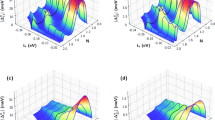Abstract
This research work focuses on the theoretical investigation of upper critical magnetic field (\(H_{C2}\)), lower critical magnetic field (\(H_{C1}\)), Ginzburg-Landau coherence length (\(\xi _{GL}\)) and Ginzburg-Landau penetration depth (\(\lambda _{GL}\)) in two-band model for the copper-based superconductors \(\hbox {YBa}_{2}\hbox {Cu}_{4}\hbox {O}_{8}\) and \(\hbox {Bi}_{2}\hbox {Sr}_{2}\hbox {CaCu}_{2}\hbox {O}_{8}\). By employing the phenomenological Ginzburg-Landau (GL) free energy density functional theory in two-band model in the presence of two superconducting order parameters, we obtained the mathematical expressions for the temperature dependence of the upper critical magnetic field (\(H_{C2}(T)\)) and lower critical magnetic field (\(H_{C1}(T)\)); the angular dependence of upper critical magnetic field, \(H_{C2}(\theta )\); the temperature dependence of GL coherence length, \(\xi _{GL}(T)\) and GL penetration depth, \(\lambda _{GL}(T)\) for the superconductors \(\hbox {YBa}_{2}\hbox {Cu}_{4}\hbox {O}_{8}\) and \(\hbox {Bi}_{2}\hbox {Sr}_{2}\hbox {CaCu}_{2}\hbox {O}_{8}\). By using the experimental values in the obtained expressions, the phase diagrams for the temperature dependence of upper critical magnetic fields parallel, \(H^{\Vert c}_{C2}(T)\) and perpendicular, \(H_{C2}^{\perp c}(T)\) to the crystallographic c-axis are plotted for \(\hbox {YBa}_{2}\hbox {Cu}_{4}\hbox {O}_{8}\) and \(\hbox {Bi}_{2}\hbox {Sr}_{2}\hbox {CaCu}_{2}\hbox {O}_{8}\). Similarly, using the obtained expressions the phase diagrams for the angular dependence of upper critical magnetic field, \(H_{C2}(\theta )\) are plotted for \(\hbox {YBa}_{2}\hbox {Cu}_{4}\hbox {O}_{8}\) and \(\hbox {Bi}_{2}\hbox {Sr}_{2}\hbox {CaCu}_{2}\hbox {O}_{8}\). We demonstrated that, the upper critical magnetic field along the ab-plane is greater than along the crystallographic c-axis for both \(\hbox {YBa}_{2}\hbox {Cu}_{4}\hbox {O}_{8}\) and \(\hbox {Bi}_{2}\hbox {Sr}_{2}\hbox {CaCu}_{2}\hbox {O}_{8}\). We have also plotted the phase diagrams for the temperature dependence of lower critical magnetic fields parallel, \(H^{\Vert c}_{C1}(T)\) and perpendicular, \(H_{C1}^{\perp c}(T)\) to the crystallographic c-axis for the two copper-based superconductors. Moreover, the phase diagrams for the temperature dependence of GL coherence lengths in the ab-plane, \(\xi ^{ab}_{GL}(T)\) and along the c-axis, \(\xi _{GL}^{c}(T)\) are plotted. Furthermore, we have plotted the phase diagrams for the temperature dependence of GL penetration depths in the ab-plane, \(\lambda ^{ab}_{GL}(T)\) and along the c-axis, \(\lambda _{GL}^{c}(T)\). Finally, the phase diagrams for the GL characteristic parameters, \(\kappa ^{c}_{GL}\) and \(\kappa ^{ab}_{GL}\) are plotted and the large values indicate that, \(\hbox {YBa}_{2}\hbox {Cu}_{4}\hbox {O}_{8}\) and \(\hbox {Bi}_{2}\hbox {Sr}_{2}\hbox {CaCu}_{2}\hbox {O}_{8}\) are extreme type-II copper-based superconductors. The results we obtained in this research work are in broad agreement with previous experimental findings.
Graphic abstract







Similar content being viewed by others
Data Availability Statement
This manuscript has no associated data or the data will not be deposited. [Authors’ comment: No Data associated in the manuscript.]
References
J.G. Bednorz, K.A. Müller, Phys. B 64(2), 189 (1986)
M.K. Wu et al., Phys. Rev. Lett. 58(9), 908 (1987)
A.I. Golovashkin et al., Physica C 185, 1859 (1991)
P.H. Hor, L. Gao, R.L. Meng, Z.J. Huang, Y.Q. Wang, K. Forster, J. Vassilious, C.W. Chu, M.K. Wu, J.R. Ashburn, C.J. Torng, Phys. Rev. Lett. 58, 911 (1987)
H. Maeda, Y. Tanaka, M. Fukutumi, T. Asano, Jpn. J. Appl. Phys. 27(2), L209 (1988)
L. Gao et al., Physica C (Amsterdam, Netherland) 213(3), 261 (1993)
L. Gao et al., Phys. Rev. B 50(6), 4260 (1994)
F. Hunte et al., Nature 453, 903 (2008)
A.A. Abrikosov, Phys. JETP 5, 1174 (1957)
H.S. Lee et al., Phys. Rev. B 80, 144512 (2009)
G. Fuchs et al., Phys. Rev. Lett. 101, 237003 (2008)
V.L. Ginzburg, L.D. Landau, Sov. J. Exp. Theor. Phys. 20, 1064 (1950)
T. Kidanemariam, G. Kahsay, Adv. Condens. Matter Phys. 2016, 5470429 (2016)
P. Udomsamuthirun, A. Changjan, C. Kumvongsa, S. Yoksan, Physica C (Amsterdam, Netherland) 434, 62 (2006)
S. Weyeneth, T. Schneider, Z. Bukowski, J. Karpinski, H. Keller, J. Phys. 20, 345210 (2008)
S. Weyeneth, T. Schneider, Phys. Rev. B 79, 214504 (2009)
Y. Simsek et al., Supercond. Sci. Technol. 31(1), 015009 (2017)
S. Kittaka, T. Nakamura, Y. Aono, S. Yonezawa, K. Ishida, Y. Maeno, Phys. Rev. B 80, 174514 (2009)
A. Changjan, P. Udomsamuthirun, Physica C (Amsterdam, Netherland) 471, 23 (2011)
C.J. Gorter, H.B.G. Casimir, Physica 1, 306 (1934)
S. Weyeneth et al., J. Supercond. Novel Magn. 22, 347 (2009)
G. Grissonnanche et al., Nat. Commun. 5, 3280 (2014)
Funding
This research received no funding.
Author information
Authors and Affiliations
Contributions
T.K. developed the title of the manuscript and carried out the computational works. Both T.K. and G.K. participated in analyzing the results and writing of the manuscript. T.D. participated in editing and verifying the manuscript. All the authors have contributed equally to the analytical and numerical calculations contained in the present manuscript.
Corresponding author
Ethics declarations
Conflict of interest
The authors declare no conflict of interest.
Rights and permissions
Springer Nature or its licensor (e.g. a society or other partner) holds exclusive rights to this article under a publishing agreement with the author(s) or other rightsholder(s); author self-archiving of the accepted manuscript version of this article is solely governed by the terms of such publishing agreement and applicable law.
About this article
Cite this article
Kidanemariam, T., Kahsay, G. & Desta, T. Investigation of anisotropic upper critical magnetic field in two-band model for the copper-based superconductors \(\mathbf {YBa_{2}Cu_{4}O_{8}}\) and \(\mathbf {Bi_{2}Sr_{2}CaCu_{2}O_{8}}\). Eur. Phys. J. B 96, 136 (2023). https://doi.org/10.1140/epjb/s10051-023-00605-z
Received:
Accepted:
Published:
DOI: https://doi.org/10.1140/epjb/s10051-023-00605-z




